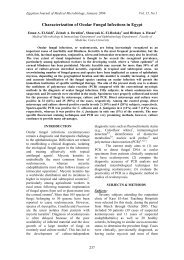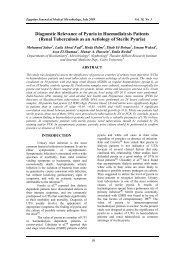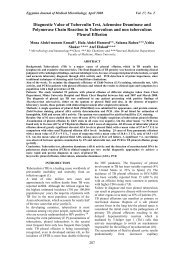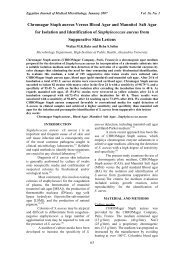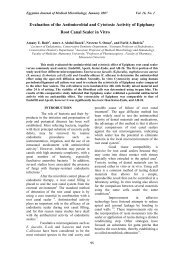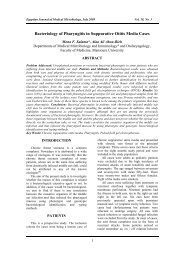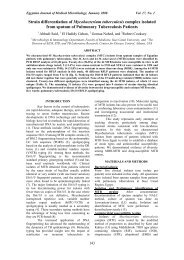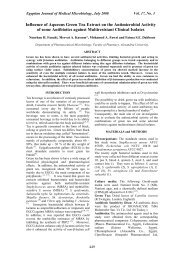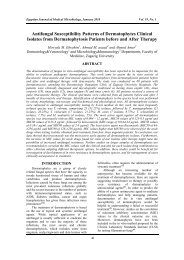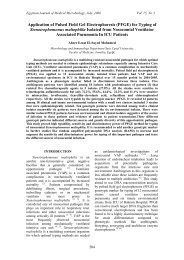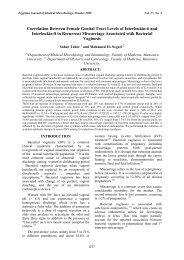Detection of group A Rota virus and characterization of G type ...
Detection of group A Rota virus and characterization of G type ...
Detection of group A Rota virus and characterization of G type ...
Create successful ePaper yourself
Turn your PDF publications into a flip-book with our unique Google optimized e-Paper software.
Egyptian Journal <strong>of</strong> Medical Microbiology, January 2007 Vol. 16, No. 1<br />
<strong>Detection</strong> <strong>of</strong> <strong>group</strong> A <strong>Rota</strong> <strong>virus</strong> <strong>and</strong> <strong>characterization</strong> <strong>of</strong> G <strong>type</strong> among<br />
Egyptian children with diarrhea<br />
Maysa A Amer 1 , Shwikar M Abdel Salam 2 , Hoda A H Ibrahim 2 , Mona A Farag 2<br />
Department <strong>of</strong> pediatrics 1 ,Department <strong>of</strong> Medical Microbiology <strong>and</strong> Immunology 2 , , Faculty <strong>of</strong> Medicine,<br />
Alex<strong>and</strong>ria University<br />
Group A rota<strong>virus</strong>es are the most important cause <strong>of</strong> acute diarrhea in children throughout the<br />
world. It is the cause <strong>of</strong> more than 450,000 deaths per year. There are few data available about<br />
rota<strong>virus</strong> <strong>type</strong> circulating in Egypt. Serotyping by ELISA with anti-VP7 sero<strong>type</strong>-specific<br />
monoclonal antibodies <strong>and</strong> genotyping by reverse transcription-PCR (RT-PCR) have been widely<br />
used for typing . The materials <strong>of</strong> this study comprised 100 stool specimens collected from children<br />
less than 5 years old suffering from acute diarrhea, attending Alex<strong>and</strong>ria University Children's<br />
Hospital at El-Shatby during the period from January to December 2006. These specimens were<br />
subjected to RT-PCR. <strong>Rota</strong><strong>virus</strong> was detected by RT PCR in 33 (33%) <strong>of</strong> patients. In the present<br />
study, a total <strong>of</strong> 30 (90.9%) <strong>of</strong> the 33 rota<strong>virus</strong> positive samples were found to be G typable <strong>and</strong> the<br />
remaining 3 (9.1%) were untypable. Out <strong>of</strong> the 33 rota<strong>virus</strong> positive cases, G4 was the main<br />
geno<strong>type</strong> detected being responsible for 12 cases (36.4%) <strong>of</strong> rota<strong>virus</strong> infections. G1 was the second<br />
most common cause <strong>and</strong> was responsible for 9 cases (27.3%) <strong>of</strong> the infections. Our study identified<br />
G9 in 6 (18.1%) <strong>of</strong> the positive cases. Mixed G <strong>type</strong>s reflecting dual infections G1+G9 were detected<br />
in 3 (3%) <strong>of</strong> the samples. G2, G3, <strong>and</strong> G8 were not detected among our cases. These results<br />
underline the importance <strong>of</strong> continued detailed epidemiological <strong>and</strong> virological studies to identify<br />
rota<strong>virus</strong> sero<strong>type</strong>s responsible for severe diarrhea, including <strong>characterization</strong> <strong>of</strong> less common <strong>and</strong><br />
or unusual strains. Knowledge <strong>of</strong> rota<strong>virus</strong> prevalence <strong>and</strong> strains circulating in the Egyptian<br />
community will add in assessing the suitability <strong>of</strong> c<strong>and</strong>idate vaccines, in order to protect against all<br />
currently circulating rota<strong>virus</strong> strains.<br />
INTRODUCTION<br />
Group A rota<strong>virus</strong>es are the most<br />
important cause <strong>of</strong> acute diarrhea in children<br />
throughout the world. It is the cause <strong>of</strong> more<br />
than 450,000 deaths per year (1). In Egypt,<br />
during the past decade, numerous studies<br />
evaluating diarrheal diseases among children<br />
living in the Nile River Delta, northern Egypt<br />
revealed that rota<strong>virus</strong> is the most commonly<br />
identified cause <strong>of</strong> diarrhea among children<br />
seeking medical care for severe illness<br />
(2,3,4,5). Development <strong>of</strong> vaccines against<br />
rota<strong>virus</strong> infection is considered a high<br />
priority in developing countries (6). However,<br />
the vaccine efficacy is being challenged by<br />
the extensive diversity <strong>of</strong> the rota<strong>virus</strong>es (7-<br />
9).<br />
The genome <strong>of</strong> rota<strong>virus</strong>es consists <strong>of</strong><br />
11 segments <strong>of</strong> double str<strong>and</strong>ed RNA (10,11).<br />
The rota<strong>virus</strong>es are distinguished by the<br />
layered proteins forming the capsid, which<br />
can be used to differentiate <strong>and</strong> classify<br />
strains, <strong>and</strong> which are important to the<br />
antigenic response. Based on the antigenic<br />
properties <strong>of</strong> the VP6 protein in the inner<br />
layer <strong>of</strong> the capsid, the rota<strong>virus</strong> genus is<br />
divided into different sero<strong>group</strong>s (labeled A<br />
through to E with two possible additional<br />
species F <strong>and</strong> G) (8,9). The clinically<br />
significant rota<strong>virus</strong>es belong to <strong>group</strong> A<br />
(12). Further classification <strong>of</strong> rota<strong>virus</strong>es is<br />
based on the genetic characteristics or<br />
seroreactivity <strong>of</strong> the VP4 <strong>and</strong> VP7 viral<br />
proteins in the outer layer <strong>of</strong> the capsid. Each<br />
<strong>of</strong> these proteins induces neutralizing<br />
antibodies independently (13). So far, 23 P<br />
geno<strong>type</strong>s <strong>and</strong> 15 G geno<strong>type</strong>s (7) have been<br />
identified. Ten <strong>of</strong> the G geno<strong>type</strong>s <strong>and</strong> 11 <strong>of</strong><br />
the P geno<strong>type</strong>s have been detected in<br />
humans ( 14 ), but most rota<strong>virus</strong>-induced<br />
diarrhea in children is caused by a small<br />
number <strong>of</strong> the G geno<strong>type</strong>s, primarily G1, G2,<br />
G3, G4, <strong>and</strong> the newly emerging strain G9<br />
(15,16,17). However, dominant strains vary<br />
between <strong>and</strong> within geographic regions. Since<br />
the rota<strong>virus</strong> sero<strong>type</strong>s (geno<strong>type</strong>s) circulating<br />
in a given region have a direct influence on<br />
the predicted efficiency <strong>of</strong> a potential vaccine<br />
for the region, an examination <strong>of</strong> the G <strong>and</strong> P<br />
<strong>type</strong> distribution is necessary (18,19).<br />
123
Egyptian Journal <strong>of</strong> Medical Microbiology, January 2007 Vol. 16, No. 1<br />
There are few data available about<br />
rota<strong>virus</strong> <strong>type</strong>s circulating in Egypt. In spite<br />
<strong>of</strong> the variety <strong>of</strong> methods used, many<br />
untypable strains remained, raising the<br />
possibility that additional sero<strong>type</strong>s may be<br />
prevalent in Egypt. This demonstrate the need<br />
to incorporate a wider variety <strong>of</strong> reagents <strong>and</strong><br />
detection methods in an attempt to identify<br />
the full variety <strong>of</strong> strains in circulation (3,6).<br />
Serotyping by ELISA with anti-VP7<br />
sero<strong>type</strong>-specific monoclonal antibodies <strong>and</strong><br />
genotyping by reverse transcription-PCR<br />
(RT-PCR) have been widely used for typing (<br />
20,21,22).<br />
MATERIAL AND METHODS<br />
The materials <strong>of</strong> this study comprised<br />
100 stool specimens collected from children<br />
less than 5 years old suffering from acute<br />
diarrhea, attending Alex<strong>and</strong>ria University<br />
Children's Hospital at El-Shatby during the<br />
period from January to December 2006. This<br />
study was approved by ″Alex<strong>and</strong>ria<br />
University Ethical Committee″, <strong>and</strong> an<br />
informed consent was obtained from all<br />
parents.<br />
All patients were subjected to<br />
thorough history taking <strong>and</strong> clinical<br />
examination at the time <strong>of</strong> specimen<br />
collection. An interview questionnaire was<br />
designed to obtain data regarding the age, sex,<br />
residence, duration <strong>of</strong> diarrhea <strong>and</strong> frequency<br />
<strong>of</strong> motions per day, the presence or absence<br />
<strong>of</strong> fever, vomiting <strong>and</strong> flu –like symptoms,<br />
the stool consistency, <strong>and</strong> the breast feeding.<br />
Sample collection.The stool specimens were<br />
obtained in a sterile container. About 30 mg<br />
<strong>of</strong> each stool sample were added to 175 ul<br />
lysis buffer containing RNase inhibitors<br />
supplied in the RNA extraction kit (Promega).<br />
The samples were transported the same day to<br />
the laboratory as they were stored at - 70 º C.<br />
RNA extraction: RNA was extracted from<br />
stool by the guanidinium isothiocyanate<br />
(GTC) <strong>and</strong> spin column extraction method<br />
using SV total RNA isolation system<br />
(Promega, Madison US), according to the<br />
manufacturer ' s instruction<br />
RT-PCR In the present study, we used the<br />
PCR assay <strong>and</strong> primers described by Gouvea<br />
et al (23) for the detection <strong>and</strong> typing <strong>of</strong><br />
<strong>group</strong> A rota<strong>virus</strong>. The primers specific for<br />
gene segment 9, (8, or 7), which encode for<br />
the VP7 glycoprotein, are used for the<br />
detection <strong>of</strong> rota<strong>virus</strong>. [Beg 9 – End 9] <strong>and</strong><br />
primers for G typing <strong>of</strong> rota<strong>virus</strong> are<br />
displayed in figure 1, <strong>and</strong> table 1.<br />
Reverse transcription. Reverse transcription<br />
was performed using Omniscript Reverse<br />
Transcriptase kit (Qiagen). The<br />
complementary DNA copies (cDNA) from<br />
both rota<strong>virus</strong> RNA str<strong>and</strong>s were synthesized<br />
in 20 ul solutions containing; 2 ul <strong>of</strong> 10 X<br />
enzyme buffer, 0.5 mM <strong>of</strong> each<br />
deoxynucleotide triphosphate, 5 picomoles <strong>of</strong><br />
each End 9 <strong>and</strong> Beg 9 primers, 10 ul <strong>of</strong> the<br />
RNA samples <strong>and</strong> 4 IU <strong>of</strong> omnireverse<br />
transcriptase enzyme. Before the addition <strong>of</strong><br />
the reverse transcriptase enzyme, the ds RNA<br />
<strong>of</strong> rota<strong>virus</strong>es were first denaturated by<br />
heating the mixture first at 97 º C for 5 minutes<br />
in the thermocycler (Techne). Then the tubes<br />
were transferred quickly to an ice-bath to<br />
prevent reannealing <strong>of</strong> the ds RNA, <strong>and</strong> the<br />
enzyme was added. The tubes were then<br />
transferred back to the thermocycler for<br />
incubation at 37 º C for one hour followed by<br />
94 º C for 5 minutes.<br />
PCR amplification. Initially, 1,062 bp (full<br />
length) gene segment 9, encoding the VP7<br />
glycoprotein in human <strong>group</strong> A rota<strong>virus</strong>, was<br />
amplified using primers Beg 9 in the forward<br />
direction <strong>and</strong> primer End 9 in the reverse<br />
direction (figure 2). Amplification was<br />
performed in a final volume <strong>of</strong> 50 µl <strong>of</strong> PCR<br />
mixture containing 1µM Of each primer, 10<br />
mΜ <strong>of</strong> each deoxynucleotide triphosphate<br />
(dATP, dGTP, d TTP, dCTP), 10 mΜ Tris<br />
HCL, 50 mΜ KCL, 0.1% Triton x-100, 1.5<br />
mΜ MgCl2, 2.5 units <strong>of</strong> Taq DNA<br />
polymerase (Qiagen), <strong>and</strong> 10 µl <strong>of</strong> cDNA.<br />
The amplification reaction was applied as<br />
follow: denaturation at 94 º C for 1 minute,<br />
annealing at 42<br />
º C for 2 minutes <strong>and</strong><br />
extension at 72 º C for 1 minute (for 25<br />
cycles), followed by a final 7 minutes<br />
extension at 72 º C.<br />
PCR typing. PCR typing was performed<br />
from dsDNA that was obtained from the first<br />
amplification <strong>of</strong> the entire gene 9. In this case,<br />
3ul <strong>of</strong> the dsDNA product served as the<br />
template for this second typing amplification.<br />
124
Egyptian Journal <strong>of</strong> Medical Microbiology, January 2007 Vol. 16, No. 1<br />
The same reaction buffer containing all six<br />
sero<strong>type</strong> specific primers [a AT8, a BT1, a<br />
CT2, a DT4, a ET3, a FT9] <strong>and</strong> RVG9 primer<br />
was used but with reduced concentrations <strong>of</strong><br />
the primer mix 200 nM each primer. The<br />
same PCR program was used with only 15<br />
cycles followed by a final extension at 72 º C<br />
for seven minutes. The PCR products were<br />
resolved by 2% agarose gel electrophoresis<br />
<strong>and</strong> were visualized after ethidium bromide<br />
(0.5 ug / ml) staining, using an UV<br />
transilluminator <strong>and</strong> photographed by<br />
Polaroid camera..<br />
RESULTS<br />
The present study was carried out in the<br />
period from January to December 2006, on<br />
100 stool specimens obtained from children<br />
less than 5 years old, who attended the<br />
Alex<strong>and</strong>ria University Hospital at el Shatby,<br />
<strong>and</strong> were diagnosed clinically as acute<br />
gastroenteritis. The mean age distribution <strong>of</strong><br />
the patients was 9 ± 7.53 months, ranging<br />
from 1 - 35 months. Fifty six percent <strong>of</strong> the<br />
patients were males <strong>and</strong> 44% were females.<br />
<strong>Rota</strong><strong>virus</strong> detection by PCR<br />
<strong>Rota</strong><strong>virus</strong> was detected by RT PCR in 33<br />
(33%) <strong>of</strong> cases. As shown in figure 2, primers<br />
Beg9 <strong>and</strong> End9 amplified gene segment 9 <strong>of</strong><br />
rota<strong>virus</strong> yielding a PCR product <strong>of</strong> expected<br />
size (1,062 bp)<br />
<strong>Rota</strong><strong>virus</strong> G-<strong>type</strong> distribution<br />
In the present study, a total <strong>of</strong> 30 (90.9%) <strong>of</strong><br />
the 33 Egyptian rota<strong>virus</strong> positive samples<br />
were found to be G <strong>type</strong>d <strong>and</strong> the remaining 3<br />
(9.1%) were untypable. As shown in table II,<br />
out <strong>of</strong> the 33 rota<strong>virus</strong> positive cases, G4 was<br />
the main geno<strong>type</strong> detected being responsible<br />
for 12 cases (36.4%) <strong>of</strong> rota<strong>virus</strong> infections.<br />
G1 was the second most common cause <strong>and</strong><br />
was responsible for 9 cases (27.3%) <strong>of</strong> the<br />
infections. Our study identified G9 in 6<br />
(18.1%) <strong>of</strong> the positive cases. Mixed G <strong>type</strong>s<br />
reflecting dual infections G1+G9 were<br />
detected in 3 (3%) <strong>of</strong> the samples. G2, G3,<br />
<strong>and</strong> G8 were not detected among our cases.<br />
As shown in figure 2, the six sets <strong>of</strong> primers<br />
used for typing yielded b<strong>and</strong>s <strong>of</strong> distinct<br />
lengths; 749, 583 <strong>and</strong> 306 bp corresponding to<br />
sero<strong>type</strong> G1, G4 <strong>and</strong> G9 respectively.<br />
By RT PCR assay rota<strong>virus</strong> was detected in<br />
children ranging in age from 1 – 23 months,<br />
with the mean age value 9 ± 5.12 months.<br />
There was no statistical significant association<br />
between sex <strong>and</strong> rota<strong>virus</strong> infection, <strong>and</strong> no<br />
statistically significant association with<br />
residence (P = 0.322). In the present study, 27<br />
(81.1%) <strong>of</strong> the rota<strong>virus</strong> positive cases did not<br />
receive any breast milk during there life,<br />
while only 6 (18.2%) were breast fed, which<br />
was found to be statistically significant, P=<br />
0.000. As shown in table III, although<br />
rota<strong>virus</strong> was detected in every season all over<br />
the 12 months <strong>of</strong> the year, a strong significant<br />
association between the seasonal trend <strong>and</strong> the<br />
incidence rate <strong>of</strong> rota<strong>virus</strong> infection (P =<br />
0.000) was found as shown in table III. The<br />
highest ratio <strong>of</strong> rota<strong>virus</strong> infections was<br />
represented in winter (60%), followed by<br />
autumn where 50% <strong>of</strong> the diarrheal cases were<br />
due to rota<strong>virus</strong> infection. <strong>Rota</strong><strong>virus</strong> infections<br />
in summer represented 33%, <strong>and</strong> the lowest<br />
incidence <strong>of</strong> rota<strong>virus</strong> diarrhea was in spring<br />
(10.9%).<br />
Table I: Primers for detection <strong>and</strong> typing <strong>of</strong> <strong>Rota</strong><strong>virus</strong>.<br />
Primer Sequence (5′-3′) Position Region<br />
Beg 9 b GGTTTTAAAAGAGAGAATCGTTTCCTGG 1-28<br />
End 9 b GGTCACATCATACAATTCTAATCTAAG 1062-1036<br />
RVG9 GGTCACATCATACAATTCT 1062_1044<br />
aAT8 GTCACACCATTTGTAAATTCG 178_198 A<br />
aBT1 CAAGTACTCAAATCAATGATGG 314_335 B<br />
aCT2 CAATGATATTAACACATTTTCTGTG 411_435 C<br />
aDT4 CGTTTCTGGTGAGGAGTTG 480_498 D<br />
aET3 CGTTTGAAGAAGTTGCAACAG 689_709 E<br />
aFT9 CTAGATGTAACTACAACTAC 757_776 F<br />
125
Egyptian Journal <strong>of</strong> Medical Microbiology, January 2007 Vol. 16, No. 1<br />
Fig. 1. <strong>Rota</strong><strong>virus</strong> gene 9 ( or gene 8) which encode the VP7 glycoprotein. Shown are locations <strong>of</strong><br />
the variable regions <strong>and</strong> PCR primers <strong>and</strong> excepted length <strong>of</strong> the amplified segment (23.) .<br />
Table II: Distribution <strong>of</strong> <strong>Rota</strong><strong>virus</strong> geno<strong>type</strong>s within the <strong>Rota</strong><strong>virus</strong> positive samples.<br />
Positive cases<br />
Geno<strong>type</strong> No. %<br />
G4<br />
G1<br />
G9<br />
Mixed<br />
Untypable<br />
12<br />
9<br />
6<br />
3<br />
3<br />
36.4<br />
27.3<br />
18.1<br />
9.1<br />
9.1<br />
Total 33 100<br />
Table III: Relation between season <strong>and</strong> <strong>Rota</strong><strong>virus</strong> infection.<br />
<strong>Rota</strong><strong>virus</strong> Winter<br />
(Dec., Jan.,<br />
Feb.,)<br />
Spring<br />
(Mar., Apr.,<br />
May)<br />
Summer<br />
(Jun., Jul.,<br />
Aug.)<br />
Autumn<br />
(Sep., Oct.,<br />
Nov.)<br />
No. % No. % No. % No. %<br />
Total<br />
Positive 18 60 5 10.9 4 33.3 6 50 33<br />
cases<br />
Negative 12 40 41 89.1 8 66.7 6 50 67<br />
cases<br />
Total 30 46 12 12 100<br />
P 0.001<br />
126
Egyptian Journal <strong>of</strong> Medical Microbiology, January 2007 Vol. 16, No. 1<br />
Fig. 2: Agarose gel electrophoresis <strong>of</strong> PCR products. Lane 1;100 bp marker, Lane 2,4,6<br />
showing rota<strong>virus</strong> positive cases, Lane 8 rota<strong>virus</strong> negative cases, Lane 3, 5 <strong>and</strong> 7<br />
showing G4, G1 <strong>and</strong> G9 respectively.<br />
DISCUSSION<br />
Diarrhoeal disease remains one <strong>of</strong> the most<br />
important public health challenges<br />
worldwide, mainly in developing countries<br />
where mortality is still high. <strong>Rota</strong><strong>virus</strong>es are<br />
the leading cause <strong>of</strong> gastroenteritis in young<br />
children. They are responsible for a so-called<br />
¨ universal infection ¨ in young children, as<br />
virtually every child will be infected by the<br />
age <strong>of</strong> 5 years (24). Therefore, the huge<br />
burden <strong>of</strong> rota<strong>virus</strong> diarrhea has made<br />
rota<strong>virus</strong> a prime target for global estimation<br />
<strong>of</strong> the prevalence <strong>and</strong> <strong>type</strong> distribution <strong>of</strong> the<br />
<strong>virus</strong> strains all over the world (7,24,25).<br />
In a study done in Egypt by Wierzba et al in<br />
2006 to identify enteropathogens for vaccine<br />
development, rota<strong>virus</strong> was <strong>of</strong> principle<br />
concern, followed by ETEC, Shigella, <strong>and</strong><br />
Campylobacter (5). Therefore, the HRV<br />
sero<strong>type</strong>s circulating in the Egyptian<br />
community should be determined. The<br />
present study was an attempt to participate in<br />
the research efforts made in Egypt for the<br />
estimation <strong>of</strong> the frequency <strong>and</strong> <strong>type</strong><br />
distribution <strong>of</strong> rota<strong>virus</strong>es, using the<br />
molecular technique RT-PCR.<br />
Typically large amounts <strong>of</strong> <strong>virus</strong> particles are<br />
present in faeces during the peak <strong>of</strong> infection,<br />
thus facilitating the diagnosis <strong>of</strong> the viral<br />
infection. However as few as 10 <strong>virus</strong><br />
particles are sufficient for the infection <strong>of</strong><br />
small children. To minimize the risk <strong>of</strong><br />
<strong>Rota</strong><strong>virus</strong> infection, an increase in sensitivity<br />
<strong>of</strong> the rota<strong>virus</strong> detection assay is therefore<br />
desirable. Conventional ELISA detection <strong>of</strong><br />
rota<strong>virus</strong> antigen VP6, a well-proven specific<br />
antigen, for all known human <strong>Rota</strong><strong>virus</strong> goes<br />
along with typical limits <strong>of</strong> detection <strong>of</strong> ≈ 1x<br />
10 5 particles/ml. Several approaches to the<br />
establishment <strong>of</strong> RT-PCR assay <strong>of</strong> the viral<br />
RNA have been described, <strong>and</strong> the limit <strong>of</strong><br />
detection was found to be ≈ 100 particles/ml<br />
(22).<br />
RT-PCR has shown greater sensitivity than<br />
ELISA for determination <strong>of</strong> human rota<strong>virus</strong><br />
G-<strong>type</strong>s 1 to 4 <strong>and</strong> 9 in previous studies<br />
(26,27,28). It appears that degradation <strong>of</strong> VP7<br />
antigen by proteolytic enzymes during<br />
freezing <strong>and</strong> thawing was a major factor in<br />
the loss <strong>of</strong> typing ability by ELISA.<br />
In the present study, <strong>Rota</strong><strong>virus</strong>es were<br />
identified by RT-PCR assays in 33 (33%) <strong>of</strong><br />
the 100 stool specimens collected from<br />
children with acute gastroenteritis, who<br />
attended the outpatient clinic in EL-Shatby<br />
Hospital in Alex<strong>and</strong>ria, over a 12 months<br />
period from January to December 2006. Our<br />
127
Egyptian Journal <strong>of</strong> Medical Microbiology, January 2007 Vol. 16, No. 1<br />
results were similar to findings from an active<br />
surveillance studies conducted in Egypt over<br />
the past decade. A five years study on the<br />
bacterial <strong>and</strong> viral etiology <strong>of</strong> infantile<br />
diarrhea in Alex<strong>and</strong>ria revealed that rota<strong>virus</strong><br />
was responsible for 15.8% <strong>of</strong> diarrheal<br />
illnesses in infants <strong>and</strong> children attended the<br />
outpatient clinic in EL-Shatby Children<br />
Hospital, during the period <strong>of</strong> 1982-1987<br />
(29). Shukry et al (1989) (30), Radwan et al<br />
(1997)(6) <strong>and</strong> El-Mougi et al (1998)(31),<br />
detected the antigen <strong>of</strong> rota<strong>virus</strong> in 33%,<br />
35.6% <strong>and</strong> 40%, <strong>of</strong> stool samples obtained<br />
from children with acute diarrhea<br />
respectively, using the ELISA technique.<br />
More recently , <strong>Rota</strong><strong>virus</strong> was detected in<br />
17% <strong>of</strong> diarrheal cases within 356 children<br />
aged ≤ 6 months, in children living in the<br />
Tamiya District <strong>of</strong> the Fayoum governorate<br />
located in Southern Egypt, between August<br />
<strong>and</strong> September 2003(32). Our results show<br />
remarkable agreement with the results <strong>of</strong><br />
other investigators in Venezuela, Spain <strong>and</strong><br />
Dhaka (33,34,35). However,in other settings<br />
(36,37), rota<strong>virus</strong> was detected with a higher<br />
percentage rates than found in our study<br />
which confirm the huge disease burden over<br />
the world, <strong>and</strong> the variability <strong>of</strong> its prevalence<br />
from a region to another.<br />
As mention before, <strong>Rota</strong><strong>virus</strong> diarrhea is<br />
widely distributed allover the world. The<br />
disease usually presents with similar<br />
epidemiological <strong>and</strong> clinical pattern within<br />
developed <strong>and</strong> developing countries. The age<br />
<strong>of</strong> the children with rota<strong>virus</strong> diarrhea<br />
detected in this study ranged between one <strong>and</strong><br />
twenty three months. The age <strong>group</strong> that<br />
experienced the highest incidence <strong>of</strong> rota<strong>virus</strong><br />
diarrhea ranged from six to twelve months,<br />
with the median age 9 months. These findings<br />
were in agreement with the previous studies<br />
done in Egypt (3, 7, 38). In addition, other<br />
investigators in different countries (39, 40)<br />
recorded that the highest rate <strong>of</strong> rota<strong>virus</strong><br />
isolation was found among children in their<br />
first year <strong>of</strong> life. These findings confirm the<br />
role <strong>of</strong> the immune system in prevention <strong>of</strong><br />
the disease, which helps decline <strong>of</strong> rota<strong>virus</strong><br />
diarrhea with age.<br />
In the present study, rota<strong>virus</strong> presented with<br />
a marked seasonal peak during the cold<br />
months <strong>of</strong> the year (December – February),<br />
similar to those observed in Engl<strong>and</strong> (41),<br />
Finl<strong>and</strong> (42), Spain (34) <strong>and</strong> Tunisia (39).<br />
Our results were similar to a previous cohort<br />
study conducted in Bilbeis (Egypt), in which<br />
the rate <strong>of</strong> rota<strong>virus</strong> isolation was<br />
predominant in the colder months (November<br />
– April). However, the seasonal peak <strong>of</strong><br />
rota<strong>virus</strong> infection in Egypt tends to shift over<br />
consecutive years (43).<br />
<strong>Rota</strong><strong>virus</strong> strain surveillance has proven to<br />
continue as a world wide effort, in order to<br />
determine the prevalent strains in each<br />
country <strong>and</strong> to apply a rota<strong>virus</strong> vaccination<br />
program that provide a sero<strong>type</strong> specific<br />
immunity to every child. Previous<br />
epidemiological studies conducted in many<br />
countries from different continents such as<br />
Tunisia (36), Nigeria (44) <strong>and</strong> Spain (34)<br />
reported that G1 rota<strong>virus</strong>es predominated as<br />
a cause <strong>of</strong> severe rota<strong>virus</strong> diarrhea, with G2,<br />
G3, <strong>and</strong> G4 strains responsible for the<br />
majority <strong>of</strong> the residual diarrhea. However,<br />
the results presented here reveal<br />
predominance <strong>of</strong> G4 (36.4%) as the most<br />
common cause <strong>of</strong> diarrhea followed by G1<br />
(27.3%) geno<strong>type</strong>.<br />
Reports <strong>of</strong> the distribution <strong>and</strong> epidemiology<br />
<strong>of</strong> human rota<strong>virus</strong> G <strong>type</strong>s in Egypt are<br />
limited in number. In a study done by<br />
Radwan et al (7), enzyme immunoassay<br />
(EIA) has been used to detect, for the first<br />
time in Egypt, the relative frequency <strong>and</strong><br />
temporal distribution <strong>of</strong> HRV G sero<strong>type</strong>s 1<br />
to 4 among the community <strong>of</strong> neonates <strong>and</strong><br />
infants with <strong>and</strong> without acute diarrhea.<br />
Sero<strong>type</strong>s G1 <strong>and</strong> G4 predominated in all age<br />
<strong>group</strong>s. Mixed (G1 plus G4) <strong>and</strong> non<strong>type</strong>able<br />
specimens represented 16.1 <strong>and</strong> 38.7% <strong>of</strong> the<br />
total number sero<strong>type</strong>d, respectively.<br />
Recently, a study in Cairo, Egypt was done on<br />
raw sewage samples taken from three sewage<br />
treatment plants based on G typing. The<br />
predominated <strong>type</strong> for rota<strong>virus</strong> identified in<br />
that study was found to be G1 (69.9%),<br />
followed by G3 (13.0%), G4 (8.7%), <strong>and</strong> G9<br />
(8.7%). The results presented in this study<br />
revealed the occurrence <strong>of</strong> G9 strains in<br />
clinical specimens in Egypt for the first time,<br />
although this does not necessarily imply<br />
emergence <strong>of</strong> new strains, since this sero<strong>type</strong><br />
was not investigated in previous studies (45).<br />
The absence <strong>of</strong> G2 <strong>and</strong> G3 geno<strong>type</strong>s in our<br />
study might reflect the absence <strong>of</strong> these<br />
strains in Egypt as have been published by<br />
128
Egyptian Journal <strong>of</strong> Medical Microbiology, January 2007 Vol. 16, No. 1<br />
Villena et al 2003 (45), where no G2<br />
rota<strong>virus</strong> geno<strong>type</strong>s were detected within the<br />
sewage samples. A more reasonable<br />
explanation is the low level circulation <strong>of</strong><br />
such strains in our community, which has<br />
been reported by Radwan et al 1997 (7),<br />
where G2 was represented with 3.2% <strong>and</strong> G3<br />
6.5% <strong>of</strong> rota<strong>virus</strong> positive samples. These<br />
findings confirm the great diversity within<br />
rota<strong>virus</strong> strains circulating in humans which<br />
make the prevalence <strong>of</strong> rota<strong>virus</strong> geno<strong>type</strong>s<br />
varies according to location <strong>and</strong> time.<br />
In the present study, rota<strong>virus</strong> geno<strong>type</strong> G9<br />
was responsible for 18.1% <strong>of</strong> the rota<strong>virus</strong><br />
infections. This percentage confirm the need<br />
for continued surveillance to identify the<br />
persistence <strong>of</strong> G9 strain in our community, as<br />
the emergence <strong>of</strong> such pathogen necessitates<br />
the urgent consideration <strong>of</strong> G9 moiety in<br />
rota<strong>virus</strong> vaccines considered for use in<br />
Egypt. Since the introduction <strong>of</strong> RT–PCR for<br />
rota<strong>virus</strong> genotyping, many epidemiological<br />
surveillance studies have been conducted, <strong>and</strong><br />
new data has been collected to underst<strong>and</strong> this<br />
complex epidemiology(3,37,44). However,<br />
there is considerable number <strong>of</strong> strains all<br />
over the world that remain untypable by PCR<br />
using the current primers. In the present<br />
study, 9.1% <strong>of</strong> the rota<strong>virus</strong> positive samples<br />
could not be G geno<strong>type</strong>d. However, the<br />
percentage <strong>of</strong> the untypable rota<strong>virus</strong> stains<br />
detected in sewage in Cairo (30%) was higher<br />
than that found in the current study. In<br />
addition, 38.7% <strong>of</strong> rota<strong>virus</strong> positive<br />
specimens collected from infants in Cairo by<br />
Radwan et al (6), were untypable. In other<br />
settings all over the world, the proportion <strong>of</strong><br />
rota<strong>virus</strong> strains that remain untypable exists<br />
with different ratios (37,46,47). It was<br />
suggested that failure <strong>of</strong> the currently used<br />
RT-PCR assay to characterize all rota<strong>virus</strong><br />
geno<strong>type</strong>s may be due to either failure <strong>of</strong> the<br />
laboratory to use the full range <strong>of</strong> primers<br />
required to detect uncommon strains, or the<br />
strains are novel enough that they must be<br />
sequenced so that new <strong>and</strong> special primers<br />
can be applied (47).<br />
In recent years, it was reported that<br />
accumulation <strong>of</strong> point mutation in VP7 genes<br />
was the main cause <strong>of</strong> failure <strong>of</strong> rota<strong>virus</strong> G<br />
typing. It was suggested that the use <strong>of</strong><br />
modified or degenerated primers or changing<br />
the primer binding site allow strains that were<br />
previously untypable to be completely <strong>type</strong>d<br />
through avoiding the mismatch between the<br />
primers used <strong>and</strong> VP7 genes (48-49).<br />
Moreover, following new typing<br />
methodologies like microarray procedures<br />
could be successful in <strong>characterization</strong> <strong>of</strong> all<br />
the existing rota<strong>virus</strong> strains (50).<br />
Finally, our results underline the importance<br />
<strong>of</strong> continued detailed epidemiological <strong>and</strong><br />
virological studies to identify rota<strong>virus</strong><br />
sero<strong>type</strong>s responsible for sever gastroenteritis,<br />
including <strong>characterization</strong> <strong>of</strong> less common<br />
<strong>and</strong> or unusual strains. Knowledge <strong>of</strong><br />
rota<strong>virus</strong> prevalence <strong>and</strong> strains circulating in<br />
our community will help in assessing the<br />
suitability <strong>of</strong> c<strong>and</strong>idate vaccines, in order to<br />
protect against all currently circulating<br />
rota<strong>virus</strong> strains.<br />
REFERENCES<br />
1-Parashar UD, Gibson CJ, Bresse JS, Glass<br />
RI. <strong>Rota</strong><strong>virus</strong> <strong>and</strong> severe childhood<br />
diarrhea. Emerg Infect Dis. 2006;12:304-6<br />
2- Abu-Elyazeed R,Wierzba TF, Mourad AS,<br />
Peruski Jr LF, Kay BA, Rao MR,Churilla<br />
AM, Bourgeois AL, Mortagy AK, Kamal<br />
SM, Savarino SJ, Campbell JR, Murphy<br />
JR, Naficy AB, Clemens JD<br />
Epidemiology <strong>of</strong> enterotoxigenic<br />
Escherichia coli diarrhea in a pediatric<br />
cohort in a periurban area <strong>of</strong> lower Egypt.<br />
J Infect Dis 1999;179:382– 89.<br />
3-Naficy AB, Abu-Elyazeed R, Holmes JL,<br />
Rao MR, Savarino SJ, Kim Y, Wierzba<br />
TF, Peruski L, Lee YJ, Gentsch JR, Glass<br />
RI, Clemens JD. Epidemiology <strong>of</strong><br />
rota<strong>virus</strong> diarrhea in Egyptian children <strong>and</strong><br />
implications for disease control. Am J Clin<br />
Pathol 1999; 150:770–77.<br />
4-Rao MR, Abu-Elyazeed R, Savarino SJ,<br />
Naficy AB, Wierzba TF, Abdel- Messih I,<br />
Shaheen HI, Frenck RW, Svennerholm<br />
AM, Clemens JD. High disease burden <strong>of</strong><br />
diarrhea due to enterotoxigenic<br />
Escherichia coli among rural Egyptian<br />
infants <strong>and</strong> young children. J Clin<br />
Microbiol 2003;41:4862– 4.<br />
5-Wierzba TF, Abdel-Messih IA, Abu-<br />
Elyazeed R, Putnam SD, Kamal KA,<br />
Rozmajzl P, Ahmed SF, Fatah A, Zabedy<br />
K, Shaheen HI, S<strong>and</strong>ers J, Frenck R<br />
Clinic-based surveillance for bacterial<strong>and</strong><br />
rota<strong>virus</strong>-associated diarrhea in<br />
129
Egyptian Journal <strong>of</strong> Medical Microbiology, January 2007 Vol. 16, No. 1<br />
Egyptian children. Am J Trop Med Hyg<br />
2006;74:148–53.<br />
6- Radwan SF, Gabr MK, EL-Maraghi S, EL-<br />
Saifi AF. Serotyping <strong>of</strong> Group A<br />
<strong>Rota</strong><strong>virus</strong>es in Egyptian Neonates <strong>and</strong><br />
Infants Less than 1 Year Old with Acute<br />
Diarrhea. J Clin Microbiol 1997;35:2996–<br />
8<br />
7-Kapikian AZ, Hoshino Y, Chanock RM.<br />
<strong>Rota</strong><strong>virus</strong>es. In: Fields Howley. ed. Fields<br />
Virology 4 th ed. Philadelphia: Lippincot /<br />
The Williams <strong>and</strong> Wilkins Co, 2001:<br />
1787-833.<br />
8-Estes MK. <strong>Rota</strong><strong>virus</strong>es <strong>and</strong> their<br />
replication. In: Fields Knipe DM, Howley<br />
PM, Chanock RM, eds. Fields Virology<br />
3 rd ed. New York: Raven Press,<br />
1996:1625-55.<br />
9-Desselberger U. Reo<strong>virus</strong>es. In: Collier L,<br />
Balows A, Sussman M, eds. Toply &<br />
Wilson ' s Microbiology <strong>and</strong> Microbial<br />
infections. 9 th ed. London. Sydney.<br />
Auckl<strong>and</strong>: Oxford University Press, Inc.,<br />
New York 1998: 537-51.<br />
10-Ramig RF. Genetics <strong>of</strong> the rota<strong>virus</strong>es.<br />
Annu Rev Microbiol 1997; 51: 225-55.<br />
11-Mertens PPC, Arrella M, Attoui H. Family<br />
Reoviridae. In:.Van Regenmortel MHV,<br />
Fauquet CM, Bishop DHL, Carstens EB,<br />
Estes MK, Lemon SM, Manil<strong>of</strong>f J, Mayo<br />
MA, Mc Geoch DJ, Pringle CR, Wickner<br />
RB, ed. Virus Taxonomy: classification<br />
<strong>and</strong> nomenclature <strong>of</strong> <strong>virus</strong>es. Seven<br />
reports <strong>of</strong> the International Committee on<br />
Taxonomy <strong>of</strong> Viruses. Academic press,<br />
San Diego, California:Academic press<br />
2000: 395-480.<br />
12-Bishop RF, Davidson GP, Holmes IH,<br />
Ruck BJ. Virus particles in epithelial cells<br />
<strong>of</strong> duodenal mucosa from children with<br />
acute-non bacterial gastroenteritis. Lancet<br />
1973; 1: 1281-3.<br />
13-Midthun K, Kapikian AZ. <strong>Rota</strong><strong>virus</strong><br />
vaccines: an overview. Clin Microbiol<br />
Rev. 1996; 9:423-34.<br />
14-Laird AR, Ibarra V, Ruiz-Palacios G, Guerrero<br />
ML, Glass RI, Gentsch JR. Unexpected<br />
detection <strong>of</strong> animal VP7 genes among<br />
common rota<strong>virus</strong> strains isolated from<br />
children in Mexico. J Clin Microbiol<br />
2003;41:4400-3<br />
15-Gentsch JR, Woods PA, Ramach<strong>and</strong>ran M,<br />
Das BK, Leite JP, Alfieri A, Kumar R, Bhan<br />
MK, Glass RI. Review <strong>of</strong> G <strong>and</strong> P typing<br />
results from a global collection <strong>of</strong><br />
rota<strong>virus</strong> strains: implications for vaccine<br />
development. J Infect Dis<br />
1996;174(S):30-6.<br />
16-Steyer A, Poljsak-Prijatelj M, Barlic-Maganja<br />
D, Bufon T, Marin J. The emergence <strong>of</strong><br />
rota<strong>virus</strong> geno<strong>type</strong> G9 in hospitalized<br />
children in Slovenia. J Clin Virol<br />
2005;33:7-11.<br />
17-Cunliffe NA, Bresee JS, Gentsch JR, Glass RI,<br />
Hart CA. The exp<strong>and</strong>ing diversity <strong>of</strong><br />
rota<strong>virus</strong>es. Lancet 2002;359:640-2.<br />
18-Mustafizure R, Leener KD, Goegebuer T,<br />
Wallants E, Donck IVD, Hoovels LV,<br />
Ranst MV. Genetic <strong>characterization</strong> <strong>of</strong> a<br />
novel, naturally occurring recombinant<br />
G6P[6] rota<strong>virus</strong>. J Clin Microbiol 2003;<br />
41:2088-95.<br />
19- Coulson BS. VP4 <strong>and</strong> VP7 typing using<br />
monoclonal antibodies. Arch Virol Suppl<br />
1996;12:113-8<br />
20-Gentsch, JR, Glass RI, Woods P, Gouvea<br />
V, Gorziglia M, Flores J, Das BK, Bhan<br />
MK. Identification <strong>of</strong> <strong>group</strong> A rota<strong>virus</strong><br />
gene 4 <strong>type</strong>s by polymerase chain reaction.<br />
J Clin Microbiol 1992;30:1365-73.<br />
21-Masendycz PJ., Palombo EA, Gorrell RJ,<br />
Bishop RF. Comparison <strong>of</strong> enzyme<br />
immunoassay, PCR, <strong>and</strong> <strong>type</strong>-specific<br />
cDNA probe techniques for identification<br />
<strong>of</strong> <strong>group</strong> A rota<strong>virus</strong> gene 4 <strong>type</strong>s (P<br />
<strong>type</strong>s). J Clin Microbiol 1997;35:3104-31<br />
22-Adler M, Schulz S, Fischer R, Niemeyer CM.<br />
<strong>Detection</strong> <strong>of</strong> <strong>Rota</strong><strong>virus</strong> from stool samples<br />
using a st<strong>and</strong>ardized immuno-PCR<br />
("Imperacer") method with end-point <strong>and</strong><br />
real-time detection. Biochem Biophys Res<br />
Commun 2005;333:1289-94.<br />
23- Gouvea V, Glass RI. Woods P, Taniguchi<br />
K, Clark HF, Forrester B, Fang Z.<br />
Polymerase chain reaction amplification<br />
<strong>and</strong> typing <strong>of</strong> rota<strong>virus</strong> nucleic acid from<br />
stool specimens. J Clin Microbiol 1992;<br />
28: 276-82.<br />
24-Parashar UD, Bresee JS, Gentsch JR.<br />
<strong>Rota</strong><strong>virus</strong> <strong>and</strong> severe childhood diarrhea.<br />
Emerg Infect Dis 1998; 4: 561-70.<br />
25-Parashar UD, Hummelman EG, Bresee JS,<br />
Miller MA, Glass RI. Global illness <strong>and</strong><br />
deaths caused by rota<strong>virus</strong> disease in<br />
children. Emerg Infect Dis 2003; 9: 565-<br />
72.<br />
26-Ushijima H, Koike H, Mukoyama A,<br />
Hasegawa A, Nishimura S, Gentsch J.<br />
<strong>Detection</strong> <strong>and</strong> serotyping <strong>of</strong> rota<strong>virus</strong>es in<br />
130
Egyptian Journal <strong>of</strong> Medical Microbiology, January 2007 Vol. 16, No. 1<br />
stool specimens by using reverse<br />
transcription <strong>and</strong> polymerase chain<br />
reaction amplification. J Med Virol.<br />
1992;38:292–297<br />
27-Taniguchi K, Wakasugi F, Pongsuwanna<br />
Y, Urasawa T, Ukae S, Chiba S, Urasawa<br />
S. Identification <strong>of</strong> human <strong>and</strong> bovine<br />
rota<strong>virus</strong> sero<strong>type</strong>s by polymerase chain<br />
reaction. Epidemiol Infect 1992;109:303–<br />
12.<br />
28-Coulson BS, Gentsch JR, Das BK, Bhan<br />
MK, Glass RI. Comparison <strong>of</strong> enzyme<br />
immunoassay <strong>and</strong> reverse transcriptase<br />
PCR for identification <strong>of</strong> sero<strong>type</strong> G9<br />
rota<strong>virus</strong>es. J Clin Microbiol<br />
1999;37:3187-93<br />
29-Massoud BZ, Kassem AS, Omar NY,<br />
Madkour AA. A five year study <strong>of</strong> the<br />
bacterial <strong>and</strong> viral etiology <strong>of</strong> infantile<br />
diarrhea in Alex<strong>and</strong>ria <strong>and</strong> the sensitivity<br />
<strong>of</strong> the bacterial pathogens to several<br />
antibiotics. Alex J Pediatr 1989; 3: 9-15.<br />
30-Shukry S, Zaki AM, Duo Pont L, Shukry<br />
I, EL-Tagi AM, Hamed Z. <strong>Detection</strong> <strong>of</strong><br />
enteropathogens in fatal <strong>and</strong> potentially<br />
fatal diarrhea in Cairo, Egypt. J Clin<br />
Microbiol 1986; 24: 959-62.<br />
31-El- Mougi M, Amer A, EL-Abhar A,<br />
Hughes J, El-Shafie A. Epidemiological<br />
<strong>and</strong> clinical features <strong>of</strong> rota<strong>virus</strong><br />
associated acute infantile diarrhea in<br />
Cairo, Egypt. J Trop Pediatr 1989; 35:<br />
230-3.<br />
32-EL-Mohamady H, Abdel–Messih IA,<br />
Youssef FG, Said M, Shaheen HI Farag H,<br />
Rockabr<strong>and</strong> DM, Luby SB, Hajjeh R,<br />
S<strong>and</strong>ers JW, Monteville MR, Klena JD,<br />
Frenk RW. Enteric pathogens associated<br />
with diarrhea in children in Fayoum,<br />
Egypt. Diagnostic Microbiology <strong>and</strong><br />
Infectious Disease 2006; 56: 1-5.<br />
33-Salinas B, Gonzàlez G, Gonzàlez R,<br />
Escalona M, Materàn M, Schael IP.<br />
Epidemiologic <strong>and</strong> clinical characteristics<br />
<strong>of</strong> rota<strong>virus</strong> disease during five years <strong>of</strong><br />
surveillance in Venezuela. Pediatr Infect<br />
Dis J 2004; 23: 161-7.<br />
34-Sanchez-Fauquier A, Wilhelmi I,<br />
Colomina J, Cubero E, Roman E.<br />
Diversity <strong>of</strong> <strong>group</strong> A human rota<strong>virus</strong><br />
sero<strong>type</strong>s circulating over a 4-year period<br />
in Madrid, Spain. J Clin Microbiol 2004;<br />
42: 1609-13.<br />
35-Rahman M, Sultana R, Podder G, Faruque<br />
ASG, Matthijnssens J, Zaman K, Breiman<br />
RF, Sack DA, Van Ranst M, Azim T.<br />
Typing <strong>of</strong> human rota<strong>virus</strong> sero<strong>type</strong>s:<br />
Nucleotide mismatches between the VP7<br />
gene <strong>and</strong> primer are associated with<br />
genotyping failure. Virology Journal 2005;<br />
2: 24-9.<br />
36-Armero Guardado JA, Clarà AW, Turcios<br />
RM, Chacón Fuentes RA, Valencia D,<br />
S<strong>and</strong>oval R, Barahona de Figueroa J,<br />
Bresee JS, Glass RI. <strong>Rota</strong><strong>virus</strong> in El<br />
Salvador an outbreak surveillance <strong>and</strong><br />
estimates <strong>of</strong> disease burden 2000 – 2002.<br />
Pediatr Infect Dis J 2004; 23: 156-60.<br />
37-Sanchez-Fauquier A, Montero V, Moreno<br />
S, Sole M, Colomina J, Iturriza-Gomara<br />
M, Revilla A, Wilhelmi I, Gray J. Human<br />
rota<strong>virus</strong> G9 <strong>and</strong> G3 as major cause <strong>of</strong><br />
diarrhea in hospitalized children, Spain.<br />
Emerg Infect Dis 2006;12:1536-41.<br />
38-Reves RR, Hossain MM, Mithdum K,<br />
Kapikian AZ, Naguib T, Zaki AM,<br />
DuPont HL. An observational study <strong>of</strong><br />
naturally acquired immunity to rota<strong>virus</strong><br />
diarrhea in a cohort <strong>of</strong> 363 Egyptian<br />
Children. Am J Epidemiol 1989; 130: 981-<br />
8.<br />
39-Trabelsi A, Peenze I, Pager C, Jeddi M,<br />
Steele D. Distribution <strong>of</strong> rota<strong>virus</strong> VP7<br />
sero<strong>type</strong>s <strong>and</strong> VP4 geno<strong>type</strong>s circulating<br />
in Sousse, Tunisia, from 1995 to 1999:<br />
Emergence <strong>of</strong> natural human reassortants.<br />
J Clin Microbiol 2000; 38: 3415-9.<br />
40-Veeravigrom M, Theamboonlers A,<br />
Poovorawan Y. Epidemiology <strong>and</strong> clinical<br />
manifestations <strong>of</strong> rota<strong>virus</strong> <strong>and</strong> Norwalklike<br />
<strong>virus</strong>es in Thai children. J Med Assoc<br />
Thai 2004;2:50-4<br />
41-Ryan MJ, Ramsay M, Brown D, Gay NJ,<br />
Farington CP, Wall PG. Hospital<br />
admissions attributable to rota<strong>virus</strong><br />
infection in Engl<strong>and</strong> <strong>and</strong> Wales. J Infect<br />
Dis 1996; 174: 5-11.<br />
42-Vesikari T, Rautanen T, Von Bonsdorff<br />
CH. <strong>Rota</strong><strong>virus</strong> gastroenteritis in Finl<strong>and</strong>:<br />
burden <strong>of</strong> disease <strong>and</strong> epidemiologic<br />
features. Act Pediatr 1999; 426: 24-30.<br />
43- Zaki AM, DuPont HL, El-Alamy MA,<br />
Arafat RR, Amin K, Awad MM, Bassiouni<br />
L, Imam IZ, El-Malih GS, El-Marsafie A,<br />
Mohieldin MS, Naguib T, Rakha MA,<br />
Sidaros M, Wasef N, Wright CE, Wyatt<br />
RG. The detection <strong>of</strong> enteropathogens in<br />
acute diarrhea in a family cohort<br />
population in rural Egypt. Am J Trop Med<br />
Hyg 1986; 35: 1013-22.<br />
131
Egyptian Journal <strong>of</strong> Medical Microbiology, January 2007 Vol. 16, No. 1<br />
44-Adah MI, Wade A, Taniguchi K.<br />
Molecular epidemiology <strong>of</strong> rota<strong>virus</strong>es in<br />
Nigeria: <strong>Detection</strong> <strong>of</strong> unusual strains with<br />
G2P[6] <strong>and</strong> G8P[1] specificities. J Clin<br />
Microbiol 2001; 39: 3969-75.<br />
45-Villena C, El-Senousy WM, Abad FX,<br />
Pintó RM, Bosch A. Group A rota<strong>virus</strong> in<br />
sewage samples from Barcelona <strong>and</strong><br />
Cairo: emergence <strong>of</strong> unusual geno<strong>type</strong>s.<br />
Applied <strong>and</strong> Environmental Microbiology<br />
2003; 69: 3919-23.<br />
46-Kirkood C, Bogdanovic-Sakran N,<br />
Palombo E, Masendyez P, Bugg H,<br />
Graeme B, Bishop R. Genetic <strong>and</strong><br />
antigenic <strong>characterization</strong> or rota<strong>virus</strong><br />
sero<strong>type</strong> G9 strains isolated in Australia<br />
between 1997 <strong>and</strong> 2001. J Clin Microbiol<br />
2003; 41:3649-54.<br />
47-Castello AA, Arvay ML, Glass RI,<br />
Gentsch J. <strong>Rota</strong><strong>virus</strong> strain surveillance in<br />
Latin America. A review <strong>of</strong> the last nine<br />
years. Pediatr Infect Dis 2004; 23: 168-72.<br />
48-Martella V, Terio V, Arista S, Elia G,<br />
Correnta M, Madio M, Partelli A.<br />
Nucleotide variation in the VP7 gene<br />
affects PCR genotyping <strong>of</strong> G9 rota<strong>virus</strong>es<br />
identified in Italy. J Med Virol 2004; 72:<br />
143-8.<br />
49-Arista S, Giammanco GM, De Grazia S,<br />
Colomba C, Martella V. Genetic<br />
variability among sero<strong>type</strong> G4 Italian<br />
human rota<strong>virus</strong>es. J Clin Microbiol 2005;<br />
43: 1420-5.<br />
50-Chizhikov U, Wagner M, Ivshina A,<br />
Hoshino Y, Kapikian AZ, Chumakov K.<br />
<strong>Detection</strong> <strong>and</strong> genotyping <strong>of</strong> human <strong>group</strong><br />
A rota<strong>virus</strong>es by oligonucleotide<br />
microarrray hybridization. J Clin.<br />
Microbiol 2002; 40: 2398-407.<br />
132
لإبا<br />
Egyptian Journal <strong>of</strong> Medical Microbiology, January 2007 Vol. 16, No. 1<br />
الكشف عن فيروس الروتا المجموعه الاولي وتوصيف نوع G<br />
في حالات الاطفال المصريين المصابين بالاسهال<br />
ُ<br />
يعد فيروس روتا من أهم المسببا ت للنزلا ت أ لمعوية أ لحا دة فى ألأطفا ل على مستوى العالم.<br />
ويعتبر أ لتطعيم ضد هذا ا لفيروس أ لطريقة الفعالة للسيطرة عليه والحد من إنتشاره الواسع. لهذا<br />
السبب آان المسح الشا مل لأنواع فيروس روتا من أهم الجهود المبذولة عالميًا لتحديد مدى إمكانية<br />
تطبيق النظام الخاص بالتطعيم ضد هذا ا لفيروس فى آل بلد<br />
بالمناعة الخاصة لكل نوع من أنواع ا لفيروس على حدى<br />
، حيث<br />
أن هذا أ لتطعيم يمد الطفل<br />
ُ<br />
.وقد أجريَ هذا البحث على ١٠٠ من<br />
ألأطفا ل المصابين بالإسهال الحاد ، و المترددين على مستشفى الشاطبى الجامعى<br />
للأ طفال بمدينة<br />
الإسكندرية خلا ل مدة قدرها ١٢ شهرًا إعتبا ًرا من يناير إلى ديسمبر . ٢٠٠٦ حيث قد تم فحص<br />
عينات البراز المأخوذة من هؤلاء أ لأطفا ل عن طريق التفاعل البوليميريزى المتسلسل بإستخدام<br />
إنزيم الإنتساخ الإنعكاسى للكشف عن الحمض النووي الخاص بفيروس روتا. وقد وجد<br />
من العينات آانت إيجابية لهذا الفيروس .وقد تم الكشف عن الجين الخاص بإظهار بروتين<br />
أن ٪ ٣٣<br />
VP7<br />
لتحديد أنواع فيروس روتا ضمن العينات ألإجابية ، وذلك عن طريق إستخدام التفاعل البوليميريزى<br />
. المتسلسل<br />
ووجد أن G4 هو النوع السائد للفيروس ضمن هذا البحث حيث يمثل نسبة تصل إلى<br />
. ٪ ٣٦٫٤<br />
يليه G1 الذي تصل نسبته<br />
إلى ٪ ٢٧٫٣ .<br />
و لم يتم الكشف عن<br />
أو G3 ٫ G2 من أي<br />
. G8<br />
وقد تم الكشف عن<br />
مستوى العالم<br />
G9 بنسبة ٪ ١٨٫١<br />
.<br />
، وهو من أنواع فيروس روتا المنتشرة حديثا على<br />
هذا بالإصافة إلى توصيف ٪ ٩٫١ من العينات ألإجابية بالإصابة المختلطة والتي<br />
تشمل نوعين من فيروس روتا هما<br />
G1+G9 معا. أما النسبة المتبقية من العينات ألإجابية وهي<br />
٪ ٩٫١ فلم يمكن تحديد نوع الفيروس بها. وقد وجد في هذا البحث أن أآثر الإصابات بفيروس<br />
روتا آانت في الشهور الباردة من العام (ديسمبر إلى فبراير)،<br />
وأن معظم ألأطفا ل المصابين بلغ<br />
عمرهم من ٦<br />
إلى<br />
١٢ شهرًا . ضافة إلى ذلك ، فقد وجد أن حالات الإسهال الناتجة عن الإصابة<br />
بفيروس روتا مصطحبة بالقئ وإلرتفاع درجة الحرارة و البراز السائل. هذ ه النتائج توضح أهمية<br />
استمرارية الدراسة المستفيضة من الناحية الوبائية و الفيرولوجية للتعرف على الأنواع<br />
السيرولوجية لفيروس روتا<br />
133



